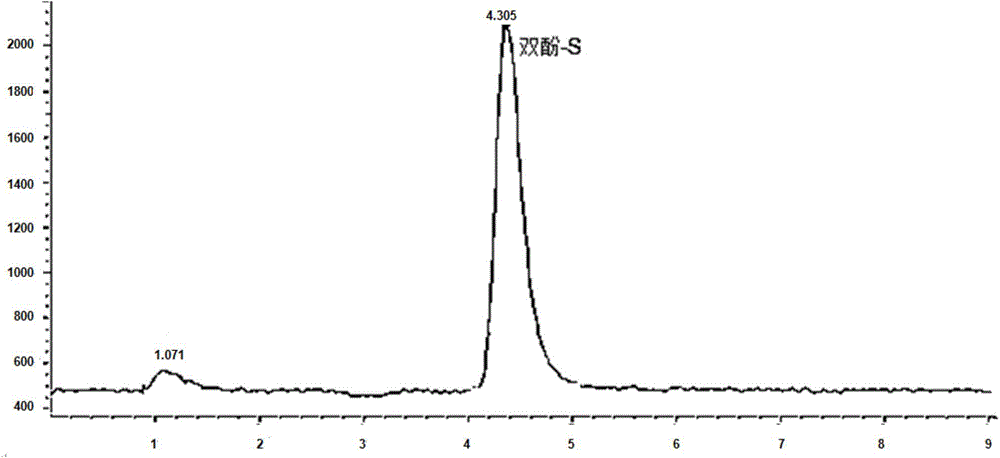Method for measuring bisphenol-S in consumer goods
A technology for consumer products, bisphenols, applied in the field of analytical chemistry, to achieve rapid results in determination methods
- Summary
- Abstract
- Description
- Claims
- Application Information
AI Technical Summary
Problems solved by technology
Method used
Image
Examples
Embodiment 1
[0046] Embodiment 1: the mensuration of bisphenol-S in the plastic water cup
[0047] 1. Sample preparation:
[0048] Cut the plastic water cup into small pieces of 2mm×2mm. Weigh 1.0 g of the uniformly mixed sample, add 15 mL of dichloromethane, mix uniformly, ultrasonically extract in a 35°C water bath for 30 minutes, and transfer the sample solution to a 250 mL flat-bottomed flask after the sample is cooled. Wash the sample extraction container with 5mL of dichloromethane, and pour the washing solution into a flat-bottomed flask. Concentrate to about 5 mL by rotary evaporation at 300 bar pressure and 70 °C water bath. Transfer this solution into a 10mL volumetric flask, wash the flat-bottomed flask several times with a small amount of methanol, incorporate the washing solution into the volumetric flask, and dilute with methanol to volume. Accurately pipette 2mL of the methanol solution into another 10mL volumetric flask, dilute with water and make up to the mark.
[004...
Embodiment 2
[0078] Embodiment 2: the mensuration of bisphenol-S in wooden chopsticks
[0079] 1. Sample preparation:
[0080] Cut the wooden chopsticks into small pieces of 2mm×2mm×2mm. Weigh 1.0 g of a uniform sample, add 20 ml of methanol, conduct ultrasonic extraction at room temperature for 30 minutes, and filter the extraction solution into a 250 mL flat-bottomed flask through filter paper. The sample was extracted once more with 20mL of methanol, and the extracts were combined. Concentrate to about 5 mL by rotary evaporation at 300 bar pressure and 70 °C water bath, transfer the solution into a 10 mL volumetric flask, wash the flat-bottomed flask with a small amount of methanol several times, put the washing solution into the volumetric flask, and dilute with methanol to volume. Accurately pipette 2mL of the solution into another 10mL volumetric flask, dilute with water and make up to the mark.
[0081] 2. Purification of the extraction solution:
[0082] Activate the HLB small ...
Embodiment 3
[0110] Example 3: Determination of bisphenol-S in brown cardboard
[0111] 1. Sample preparation:
[0112] Cut the brown cardboard into small pieces of 2mm×2mm×2mm. Weigh 1.0 g of a uniform sample, add 20 ml of methanol, conduct ultrasonic extraction at room temperature for 30 minutes, and filter the extraction solution into a 250 mL flat-bottomed flask through filter paper. The sample was extracted once more with 20mL of methanol, and the extracts were combined. Concentrate to about 5 mL by rotary evaporation at 300 bar pressure and 70 °C water bath, transfer the solution into a 10 mL volumetric flask, wash the flat-bottomed flask with a small amount of methanol several times, put the washing solution into the volumetric flask, and dilute with methanol to volume. Accurately pipette 2mL of the solution into another 10mL volumetric flask, mix well and filter it with a 0.22μm filter membrane into the sample injection vial, analyze with LC / MS to determine the amount of bispheno...
PUM
| Property | Measurement | Unit |
|---|---|---|
| length | aaaaa | aaaaa |
| particle diameter | aaaaa | aaaaa |
| particle diameter | aaaaa | aaaaa |
Abstract
Description
Claims
Application Information
 Login to View More
Login to View More - R&D
- Intellectual Property
- Life Sciences
- Materials
- Tech Scout
- Unparalleled Data Quality
- Higher Quality Content
- 60% Fewer Hallucinations
Browse by: Latest US Patents, China's latest patents, Technical Efficacy Thesaurus, Application Domain, Technology Topic, Popular Technical Reports.
© 2025 PatSnap. All rights reserved.Legal|Privacy policy|Modern Slavery Act Transparency Statement|Sitemap|About US| Contact US: help@patsnap.com


